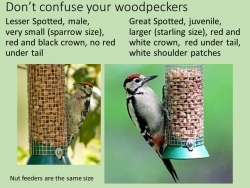Now, late May and early June, is the perfect time to find and observe Lesser Spotted Woodpecker nests. We have lots of reports of Great Spot nests with adults feeding noisy young. Lesser Spots are usually a week or so later. From our experience of monitoring over 60 Lesser Spot nests in the last few years, this is the easiest time to find a nest. The adults will be bringing food every few minutes and as they get nearer to fledging the young start to call from the nest.
If you are able to, please visit any site where you saw a Lesser Spot earlier in the year or other likely Lesser Spot woodlands and look for a nest. here is the information needed:
If you find a nest please let us know and make a note of the location, dates and times, habitat species of nest tree and height of the nest hole.
Observe the behaviour of the Woodpeckers to judge the progress of the nest and send us all the details to contribute to the project.
- During chick rearing the young are fed every 5-10 minutes and their age can be worked out from the adult behaviour.
- For the first week after hatching the young are always brooded by one of the adults so there is a changeover every time the young are fed.
- The young are usually fed inside the cavity until their last week when they can be fed at the nest hole with the adults only going in occasionally.
- For their last 2-3 days in the nest the young can be quite noisy making insistent begging calls (but not always) and can often be seen looking out of the nest hole waiting to be fed.
- Please take photographs, where appropriate, and take care not to disturb the birds.
- We are particularly interested in the food being brought for the young, for example, caterpillars or aphids. If these can be seen in photos so much the better.
We will treat all records in complete confidence and will not publish any details of nest sites. The nest records will be treated as confidential by the BTO.
Please get in touch and good luck - Ken and Linda Smith - Lesser Spot Network.



